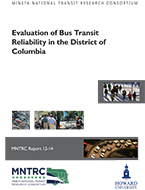Abstract:
Several performance metrics can be used to assess the reliability of a transit system. These include on-time arrivals, travel-time adherence, run-time adherence, and customer satisfaction, among others. On-time arrival at bus stops is one of the performance metrics of the Washington Metropolitan Transit Authority (WMATA). A bus is considered to be on time by WMATA if it arrives at most two minutes earlier or seven minutes later than the scheduled arrival times, with a performance goal of 78%. Most regional transit agencies consider arrivals that fall within one minute earlier or five minutes later than the scheduled arrival times as being on time. The goal of this project was to determine the on-time performance and their statistical significance based on WMATA’s advertised threshold and the industry standard for on-time arrivals. Fifteen bus routes in Washington DC with several stops were studied in this research. WMATA’s published bus schedules provided expected arrival times. An on-board manual survey was conducted from June 2012 through June 2013 for peak morning and afternoon travel on those routes during which the actual arrival times at the bus stops were noted and compared with the scheduled arrival times. For WMATA’s two-minutes-early and seven-minutes-late arrival threshold, the buses were found to be on time approximately 82% of the time, on average, during the morning. In the evening, for the same threshold, only 68% of the buses on average were considered to be on time. This results in an overall on-time performance of 75%, which is a modest improvement over the 2010 on-time performance of 74%. Based on the one-minute-early and five-minutes-late arrival threshold used by several regional transit agencies, the buses were found to be on time approximately 67% of the time during the morning and 55% in the evening, resulting in an overall performance of 61%.
Authors:
STEPHEN ARHIN, PH.D., P.E., PTOE
Dr. Arhin is an Assistant Professor of the Department of Civil and Environmental Engineering of Howard University, the Associate Director of the Howard University Transportation Research and Traffic Safety Data Center (HUTRC), and the Associate Director of the transit research conducted by Howard University under the Mineta National Transit Research Consortium. His experience spans more than 18 years in all facets of transportation and traffic safety engineering, including traffic safety and operations, research, planning, transit operations and ITS. He has extensive experience working with state and local transportation agencies on a wide variety of safety, operations, and design projects. Prior to his tenure at HUTRC, he was a Senior Traffic Engineer with a number of nationally recognized engineering consulting firms. Dr. Arhin has co-authored several project reports, published articles in peer-reviewed journals and presented at conferences on such topics as countdown pedestrian traffic signals, intelligent transportation technologies, pavement condition monitoring, crash data analysis, traffic volume trends, mitigation of reflective cracking in composite highway pavements, truck weight enforcement and red-light violation index. He is a member of ITE, TRB and ASCE and serves as a peer reviewer for several journals.
ERROL C. NOEL, PH.D., P.E., F. ASCE
Dr. Noel is a tenured full professor and Chair (2000-2010) of the Department of Civil and Environmental Engineering of Howard University, Director of the Howard University Traffic Safety and Transportation Data Center, and Director for transit research conducted by Howard University under the Mineta National Transit Research Consortium. He teaches graduate and undergraduate courses in traffic and highway engineering, project management, and engineering systems analysis, and has been continuously involved as principal investigator on numerous sponsored research projects as faculty and consultant. In recent years, his research focus has been in applied research for solving urban transportation problems. In parallel with his responsibilities at Howard University, he has more than forty years of professional engineering experience, particularly in the field of highway engineering, traffic engineering, and transportation research. He is a member of ITE, ASCE, TRB and ASEE and has an outstanding record of published articles. Since 1998 his research has involved urban transit operation and safety, management of snow removal using intelligent transportation technologies, pavement ride quality and condition monitoring, traffic-induced vibration, innovations in countdown traffic signals, mitigation of reflective cracking in composite highway pavements, policy on truck weight enforcement, red-light violation index, and standards for red traffic signal installation.


